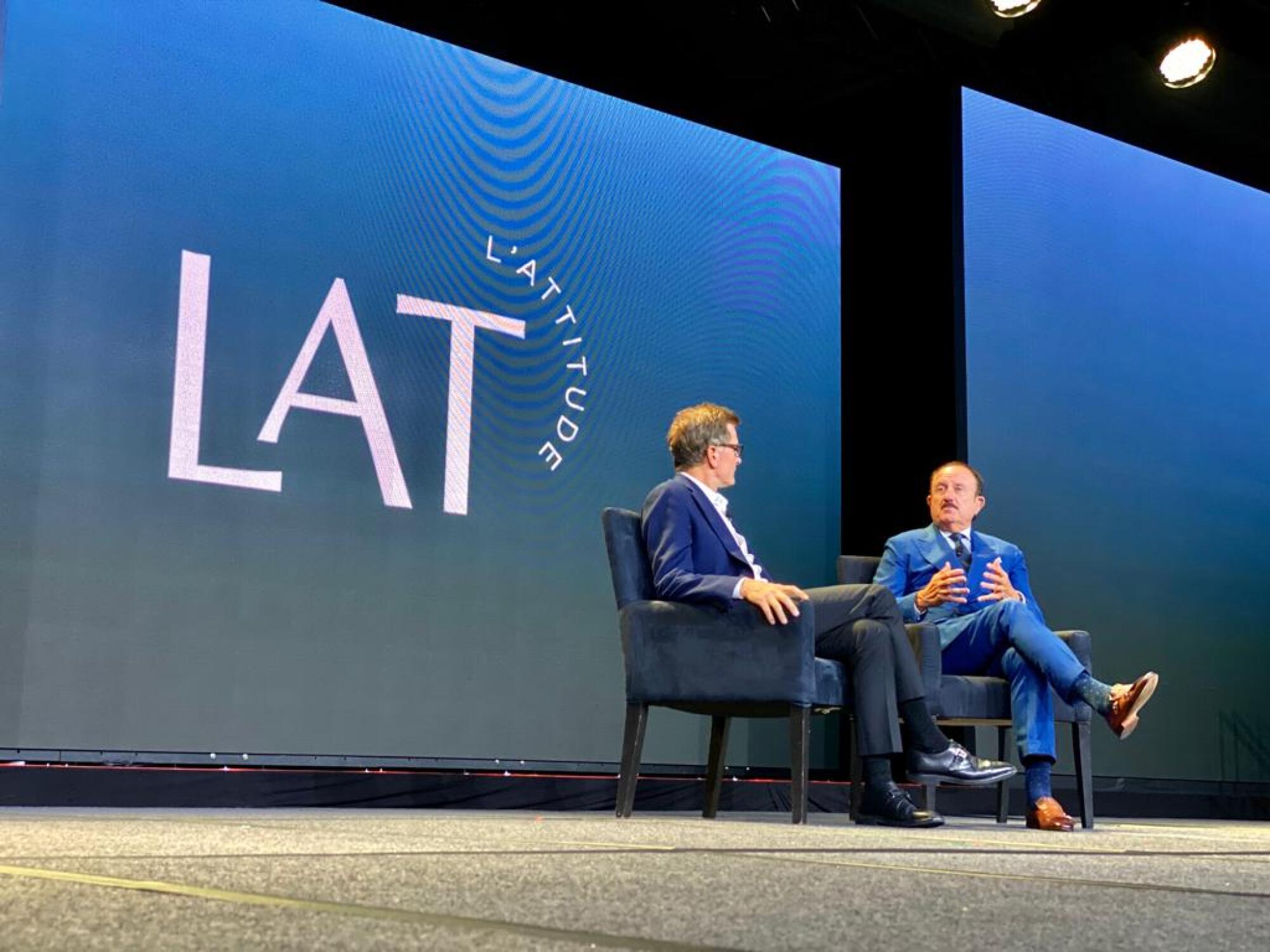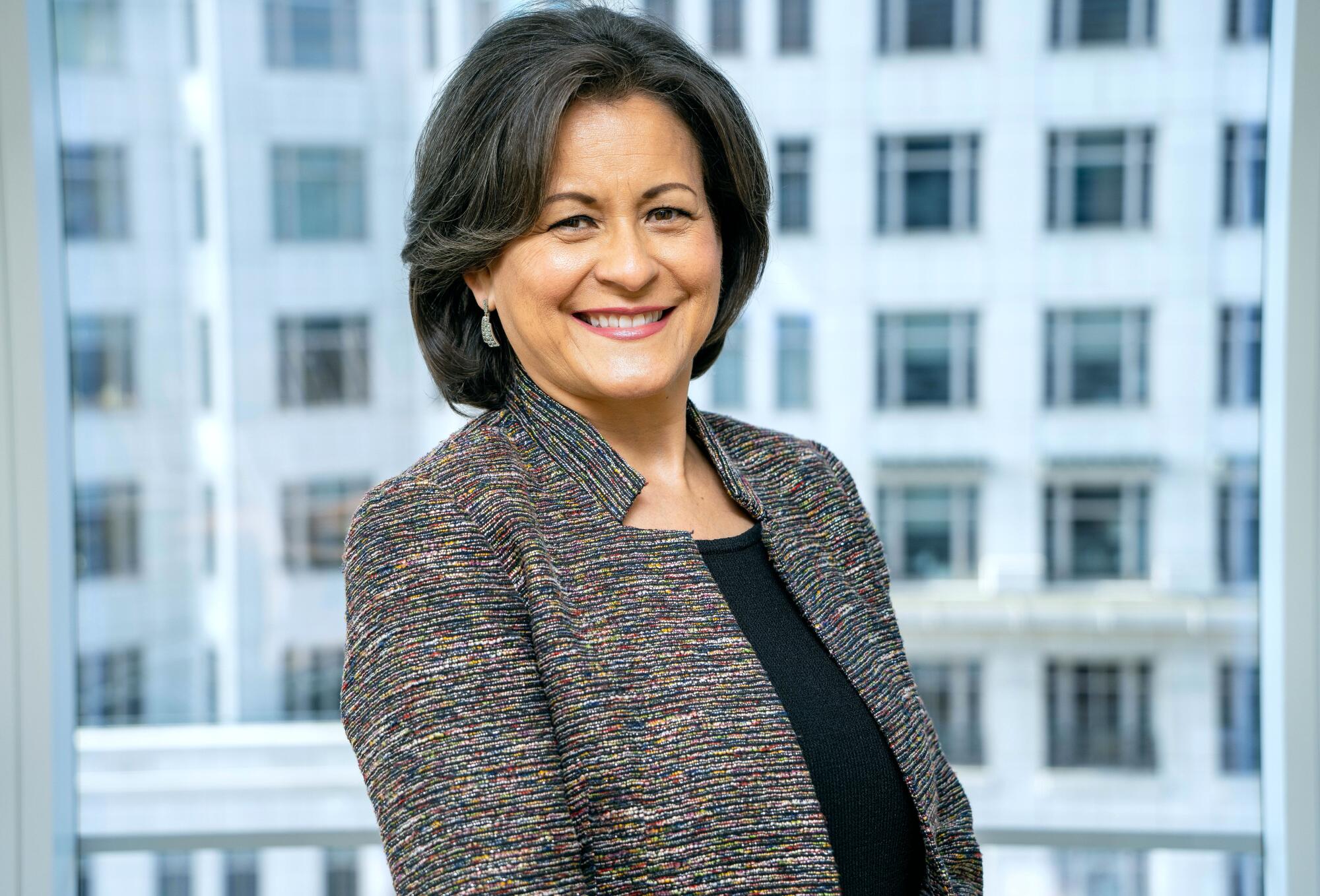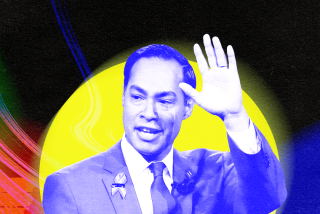
- Share via
Cisco Systems, the multinational tech giant based in San Jose, has no Latino on its board of directors.
Ditto for Intel, the world’s largest semiconductor manufacturer, headquartered in Santa Clara, Calif.
Ditto for Tesla — which moved offices to Austin, Texas, from Palo Alto last year — and for a host of other Fortune 100 companies with millions of Latino customers, employees and suppliers. Among them: Amazon, FedEx, Albertsons, Kroger, Walgreens Boots Alliance, Exxon Mobil, Citigroup, JPMorgan Chase, United Parcel Service and Berkshire Hathaway.
Latinos are the nation’s largest ethnic or racial minority — accounting for 18.9% of the population — and its fastest-growing group. In California, 40% of residents trace their roots to Mexico or Central or South America.
Yet even as companies tout their commitment to diversity, equity and inclusion, Latinos are far less likely to ascend to the pinnacle of business power in mostly white boardrooms than Black Americans, who account for 13.6% of the U.S. population, or Asian Americans at 6.1%.
Ruben Salazar is mostly remembered today as a pioneering L.A. Times columnist. But 60 years ago this week, he wrote a groundbreaking series on L.A.’s Mexican American community. We revisit it.
“We remain a blind spot for corporate America,” said Esther Aguilera, chief executive of the Latino Corporate Directors Assn., an advocacy group founded in 2013. “The narrative has been, ‘We can’t find qualified Latinos.’ But there’s ample talent.”
Across a huge screen at a recent San Diego business conference, before 6,300 executives and professionals, Aguilera splashed the names of 47 of the nation’s Fortune 100 corporations with no Latino directors.
Beyond the naming and shaming, she contrasted Latinos with other people of color. A slide showed what she called “the stark reality” of S&P 500 boards: Black directors at 11%, Asian directors at 6% and Latino directors at 5% in 2022.
Companies, she said later, promote people based on “perceptions of who’s worthy … and Latinos are at the bottom of the barrel. Yet Latino talent is right under their nose.”
The issue of who benefits from inclusion initiatives — and who doesn’t — is at the heart of affirmative action debates across the nation. California ballot initiatives have outlawed preferences in public university admissions and government contracting. A high-profile case before the U.S. Supreme Court argues that Asian students lose out when colleges favor Black and Latino applicants.
“We don’t want anybody to be under-engaged, whether they’re African American or Asian American or Anglo American. But we do want to see Latino and Latina Americans at par,” said Solomon Trujillo, a former chief executive of telecommunications firm U.S. West who joined Western Union’s board in 2012.
“When you hear CEOs and everybody talk about ‘I believe in diversity and inclusion,’ I say show me the numbers.”

Trujillo co-founded the Latino Donor Collaborative, a Beverly Hills nonprofit that publishes an annual Latino GDP report. Its latest research, by scholars at UCLA and California Lutheran University, pegs the economic impact of the nation’s 62 million Latino consumers at $2.8 trillion in 2020. And in 2018, he co-founded L’Attitude, the conference where Aguilera shared her findings, as a way to showcase Latino contributions.
Trujillo condemns the dearth of Latino board members, given the size of the Latino market and the importance of cultural knowledge. Companies without Latino directors risk “leaving money on the table,” he said.
From the dais at L’Attitude, he asked attendees: “How many of you use an Exxon station to refuel? Guess who are the most people on the road, commuting to work every day? It tends to be Latinos in many of the major markets in our country. So you have to ask, why don’t they want a Latino or Latina on their board?”
An Exxon Mobil spokesperson declined to comment on the lack of Latinos on the company’s 13-member board, which has two Black directors, but said the board “believes diversity of thought, experience, and background is critical for successful governance.”
Cisco and Intel spokespeople said their leaders value diversity but declined to elaborate on why their boards, which include Black and Asian directors, have no Latinos. Other Fortune 100 companies called out for lacking Latino directors offered statements of support for diversity without addressing the composition of their own boards.
Bold tactics, mixed results
Corporate boards, ranging from about five to more than a dozen members, wrestle with complex challenges, including fluctuating profits, shareholder revolts and corporate raiders. Also on their agendas: environmental impact, climate change, social justice and how the company is governed.
Directors — chosen for their expertise in strategy, finances, legal issues, digital transformation and marketing — attend an average of eight meetings a year and their compensation at the 500 most valuable U.S. companies averaged $316,000 last year, according to consulting firm Spencer Stuart.
“Corporate boards are where companies’ culture is established, how they make decisions and target resources,” said Assemblyman Chris Holden (D-Pasadena), a former Black caucus chair and the main author of a landmark California law in 2020 that mandated racial and ethnic diversity on company boards.
Diverse directors can offer fresh perspectives.
Aguilera cites a large consumer products company, which she declined to name, whose board planned to look for new markets abroad. A Latina director pushed back. “She argued, ‘We have an untapped market here, right in our back yard, which is the Latino market.’ She influenced growth and shareholder value.”
Netflix, HBO Max and others are investing in Spanish-language content to target U.S. Latinos and Latin American markets.
But frustration over the slow pace of progress is spurring bold tactics. Latino Voices for Boardroom Equity, a coalition including civil rights groups UnidosUS and the Mexican American Legal Defense and Educational Fund, has launched a public online tracker showing how many Latinos, if any, are on the board of each Fortune 1000 company.
So far, 650 lack any Latino director. The group’s mission: Increase the ratio of Latino directors to 1 in 5 — equivalent to the Latino share of the U.S. population.
The coalition first targeted U.S. companies based in the Golden State, and not just due to its huge Latino population. The group aimed to boost enforcement of that 2020 director law, Assembly Bill 979, which was the first in the nation to target race and ethnicity.
The measure required publicly traded companies based in California to appoint directors from “underrepresented” communities.” The definition included individuals self-identifying as Black, African American, Hispanic, Latino, Asian, Pacific Islander, Native American, Native Hawaiian, Alaska Native, gay, lesbian, bisexual or transgender.
An earlier law in 2018, also a first, had ordered California companies to appoint female directors. Both board measures are mired in litigation. Conservative challengers argue that any quotas violate the California Constitution’s equal-protection clause.
“We are outraged that companies like Facebook, Netflix, PayPal, PG&E, Molina Healthcare, Ross Stores, Chipotle Mexican Grill, El Pollo Loco, and Del Taco Restaurants have no Latinos on their board of directors,” declared a coalition statement in late 2020, amplified by a social media campaign.
The strategy drew results. Since the call-out, seven of the nine companies have added Latinos to their boards — all except Netflix and Molina Healthcare.
A Molina spokesperson said the company’s next new director will be Latino or Latina. A Netflix spokesperson said, “We’ve met with the Latino Voices for Boardroom Equity and look forward to continued discussions.”
Over the last two years, the coalition has written to more than 580 chief executives of publicly traded California corporations declaring it “unacceptable” that “your company profits from Latino culture and Latino purchasing power, but your corporation has no Latinos on its board of directors.”
The letters, offering to provide lists of “highly qualified” candidates, request meetings to discuss diversity plans “inclusive of Latinos.” But the tally is so far underwhelming: Just 3.7% of the directors of California’s largest 505 companies are Latino, according to a January survey by the data analytics firm ISS Corporate Solutions. That compares with 14.6% who are Asian and 6.2% who are Black.
Why boards lack Latinos
Latino leaders say their corporate struggles are in part related to a dearth of positive portrayals in movies and television along with the media’s intense focus on illegal immigration, leading to negative stereotyping.
“We’re often seen as the housekeepers, the farmworkers, the mechanics,” said former California Assemblywoman Cristina Garcia (D-Bell Gardens), co-author of the board diversity bill. “Culturally, this sense of what we are eligible to do limits us.”
Among U.S. professionals, a quarter are Latino, a five-point gain over the last decade and higher than Latinos’ general population share, according to a McKinsey report last year.

But recently a Latina financier who manages client assets of $2 billion told Aguilera that she has attended business meetings where “someone will tell her, ‘Oh, can you clean the table?’ That’s people’s perceptions,” Aguilera said.
Momentum and timing are also factors.
The Executive Leadership Council, a group aimed at promoting Black executives, was formed in 1986 — 27 years before the Latino Corporate Directors Assn. And George Floyd’s murder in May 2020, while fueling the push to hold corporate boards accountable on diversity, boosted the appointment of Black directors far more than those from other racial and ethnic groups.
Among the largest 3,000 public corporations, the proportion of Black directors has surged 90% since 2019 — more than any other racial or ethnic group, according to an ISS Corporate Solutions analysis.
By comparison, the share of Asians rose 55% and Latinos, 37%. The proportion of white directors fell 9% to 79.9% of the more than 26,000 directors.
“The civil unrest brought issues of equity and disenfranchisement to the fore,” said Holden, the California diversity law author. “In a state with a majority minority population, why weren’t we seeing greater progress?”
After the Floyd video release, “you had a lot of corporations making promises about diversity,” co-author Garcia said. “We saw an opportunity — let’s make good on those promises, starting with corporate boards.”
But merely requiring companies to source from a broad swath of underrepresented communities, without differentiating by race or ethnicity, ended up shortchanging Latinos, she said.
“Companies think, ‘We checked off the minority box. We have a Black person or a gay person.’ But they haven’t lifted all boats equitably.”
In the last decade, the two largest race discrimination cases brought by the federal government in the Golden State alleged widespread abuse of hundreds of Black employees at Inland Empire warehouses.
Holden calls the law “a toe in the water. If you pick one director from any one of these underrepresented groups, you’re in compliance,” he said. “But the numbers show a gross under-representation for Hispanics. Companies must find ways of recruiting [and] maybe add more positions to their boards.”
Even if ultimately invalidated in court, the California law’s approach — measuring diversity through a wide lens of underrepresented groups — dovetails with a national template.
Corporations on the Nasdaq stock exchange must publicly disclose their board demographics. They must have at least one female director or one “underrepresented minority” or LGBTQ+ director by the end of this year, and, for larger boards, two by the end of 2025. Or they must explain why they don’t.
But companies can satisfy the rule without appointing any Latinos — and many have done so. They “clump” diverse directors together, Trujillo said. “A minority is a minority is a minority, right?”
The percentage of Asian directors has also grown faster than that of Latinos, in part because companies expanding into China, India and Southeast Asia “wanted Asian board members that could relate to the Asian market space,” Trujillo said.
Julie Daum, a board expert at Spencer Stuart, said companies particularly focused on recruiting Black directors after the George Floyd murder, and if fewer Latinos are appointed, “it’s not that they’re excluding people.”
“The notion of diversity is that you have different points of view in the room, people who don’t all look alike,” Daum said. “So they’re using the category ‘underrepresented,’ but I don’t think it’s that you need one of this and one of that.
“Are we going to say, ‘I’m blond. Now we need a person who has dark hair in the room because blonds have a different experience’? We have to be very careful about dividing us all into teeny tiny little bits.”
Diversity boosts profits
Aguilera and other activists are leaning on institutional investors, including pension funds and banks, to pressure companies to appoint Latino directors. They cite recent studies from organizations such as McKinsey, Carlyle Group and the nonprofit BoardReady, reporting that diversity correlates with higher profits.
Although large investors are not pledging to specifically advocate for Latino directors, they are pushing for general diversity, including women and minority directors.
Goldman Sachs has said it would help companies go public only if they have at least two diverse board members. Glass Lewis, the proxy advisory services firm, is recommending voting against board nominating committee chairs at companies with no directors from underrepresented communities.
“Institutional investors are powerful,” Aguilera said. “They want different perspectives in the boardroom. They’ve been writing letters for women. I said, ‘Why aren’t you writing letters for Latinos?’ And they said, ‘Give us the data.’”
The collaborative’s GDP report makes an economic case: From 2010 to 2020, Latinos accounted for more than half of U.S. population growth and their consumption grew more than three times faster than that of non-Latinos.
The directors association offers a database of several thousand experienced Latino executives eager for board appointments, many of whom have trained in the organization’s workshops.
“The saying is, if you’re not in the boardroom, you’re on the menu, right?” Aguilera said. “Well, Latinos, we’re not even on the menu. We’re not in the room. We’re not even in the darn elevator.”
The group plans to ramp up public pressure, launching media campaigns comparing companies by industry — for instance, contrasting Target, with three Latina directors, to other large retailers with none.
“There’s a lot of competition between companies,” Aguilera said. “When you put their names out there, they’ll listen.”
Target’s Latino board members are Monica Lozano, former chair of U.S. Hispanic Media Inc., Grace Puma, the retired PepsiCo Inc. chief operations officer, and Melanie Healey, a former Procter & Gamble group president. And that diversity won CEO Brian Cornell a high-profile slot at the San Diego conference, where he stressed “how important the Latino consumer is for our future growth” and pledged to keep expanding Target’s staff of 120,000 Latino employees.
“Give Brian a great round of applause,” Trujillo urged the crowd. “We don’t talk about diversity and inclusion. We talk about business. And if you’re a good businessperson, you’re going to know who your customers are.”
More to Read
Inside the business of entertainment
The Wide Shot brings you news, analysis and insights on everything from streaming wars to production — and what it all means for the future.
You may occasionally receive promotional content from the Los Angeles Times.













